Physical Address
304 North Cardinal St.
Dorchester Center, MA 02124
After gastrulation is complete, the embryo proper consists of a flat, three-layered disk containing the ectodermal, mesodermal, and endodermal germ layers. Its cephalocaudal axis is defined by the location of the primitive streak. Because of the pattern of cellular migration through the primitive streak and the regression of the streak toward the caudal end of the embryo, a strong cephalocaudal gradient of maturity is established. This gradient is marked initially by the formation of the notochord and later by the appearance of the neural plate, which results from the primary induction of the dorsal ectoderm by the notochord.
As seen in Chapter 5 , despite the relatively featureless appearance of the gastrulating embryo, complex patterns of gene expression establish the basic body plan of the embryo. One of the earliest morphological manifestations of this pattern is the regular segmentation that becomes evident along the craniocaudal axis of the embryo. Such a segmental plan, which is a dominant characteristic of all early embryos, becomes less obvious as development progresses. Nonetheless, even in an adult the regular arrangement of the vertebrae, ribs, and spinal nerves persists as a reminder of humans’ highly segmented phylogenetic and ontogenetic past.
Another major change crucial in understanding the fundamental organization of the body plan is the lateral folding of the early embryo from three essentially flat, stacked, pancakelike disks of cells (the primary embryonic germ layers) to a cylinder, with the ectoderm on the outside, the endoderm on the inside, and the mesoderm between them. The cellular basis for lateral folding is still better described than understood.
This chapter concentrates on the establishment of the basic overall body plan. In addition, it charts the appearance of the primordia of the major organ systems of the body from the undifferentiated primary germ layers (see Figure 6.32 ).
The principal early morphological response of the embryonic ectoderm to neural induction is an increase in the height of the cells that are destined to become components of the nervous system. These transformed cells are evident as a thickened neural plate visible on the dorsal surface of the early embryo ( Figures 6.1A and 6.2A ). Unseen but also important is the restricted expression of cell adhesion molecules (Ig-CAMs), from N-CAM and E-cadherin in the preinduced ectoderm to N-CAM and N-cadherin in the neural plate (see Figure 5.18 ).
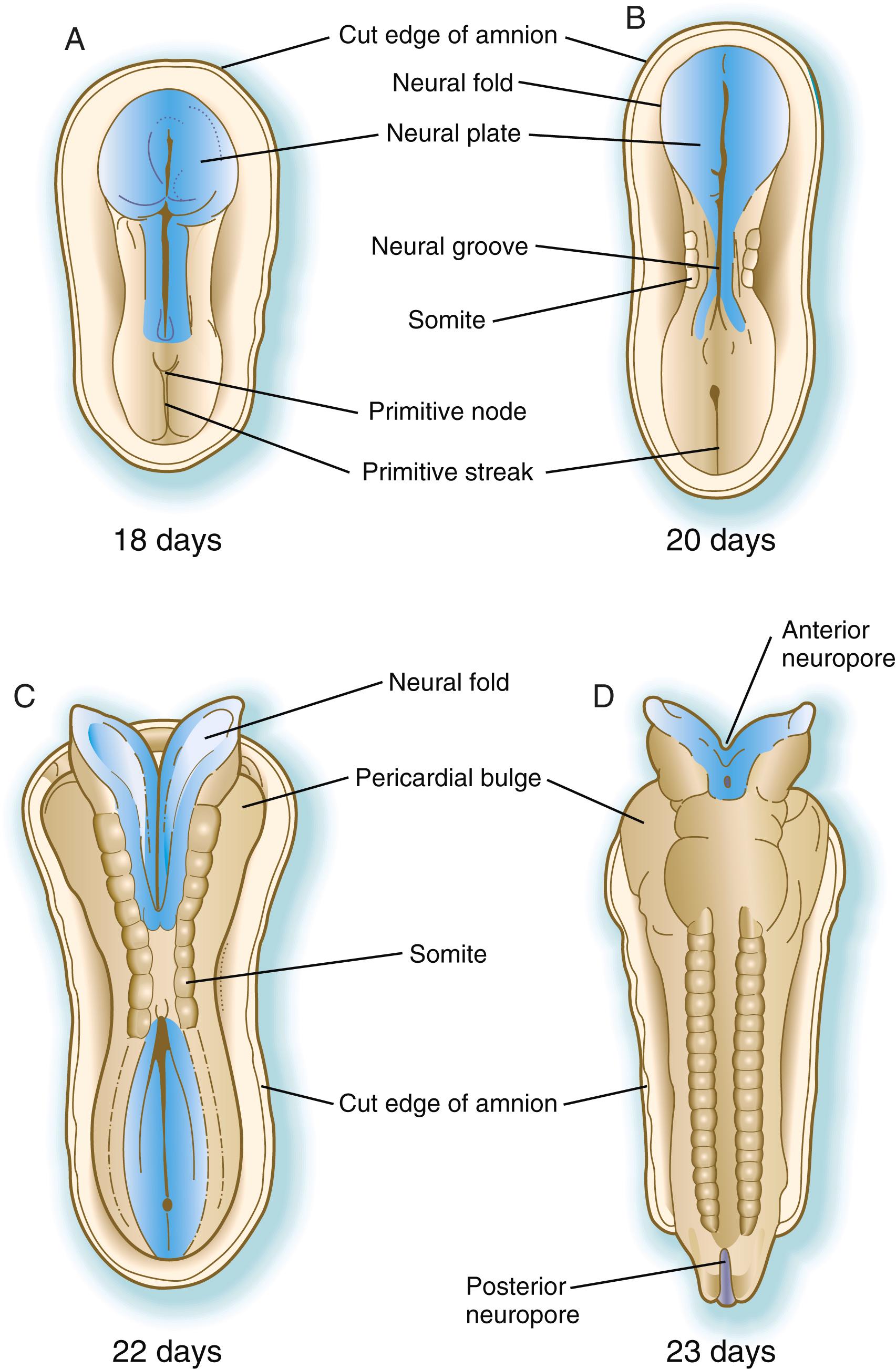
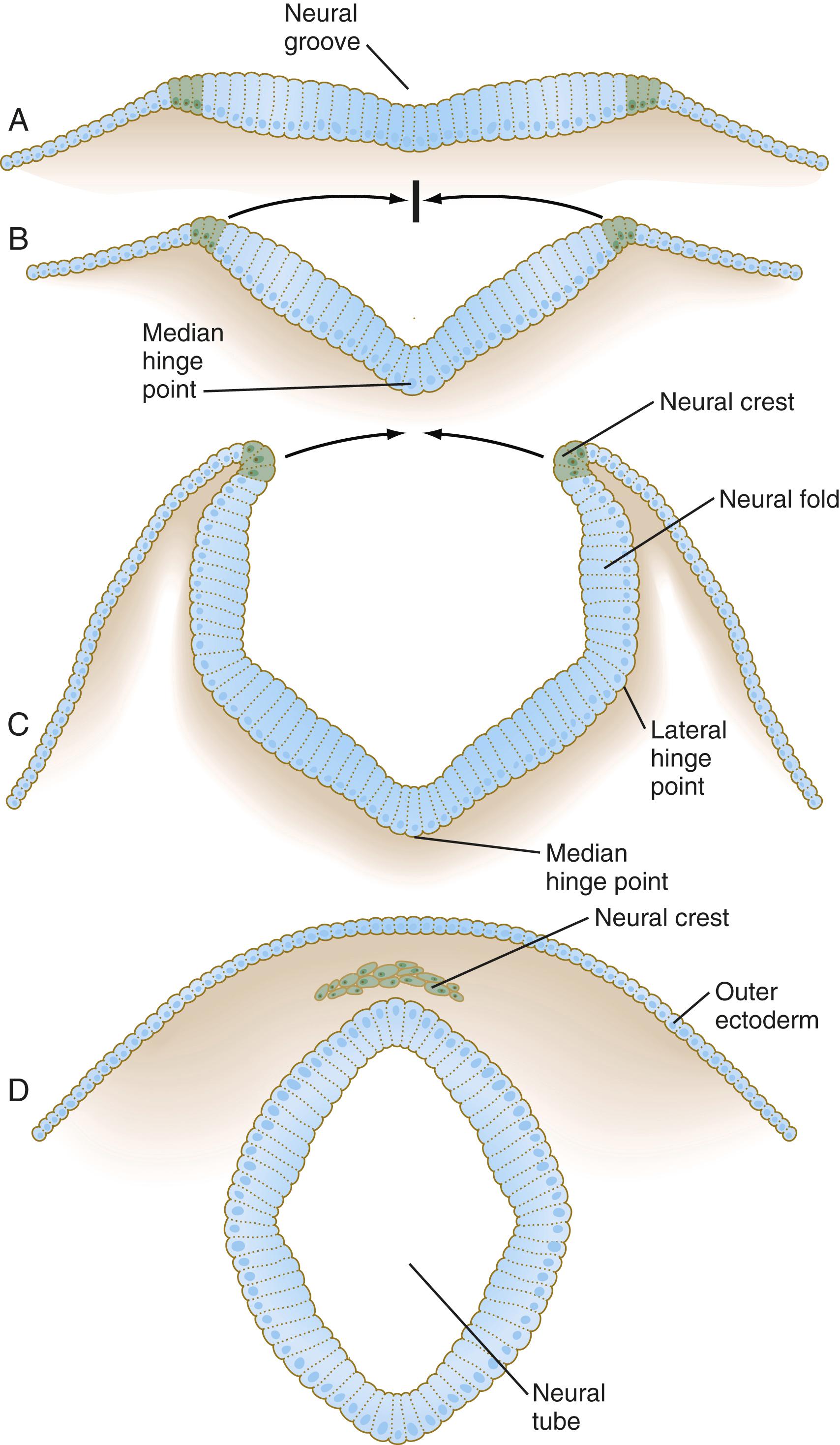
The first of four major stages in the formation of the neural tube is transformation of the general embryonic ectoderm into a thickened neural plate. The principal activity of the second stage is further shaping of the overall contours of the neural plate so that it becomes narrower and longer. To a great extent, this is accomplished by convergent extension , during which the ectodermal cells forming the neural plate migrate toward the midline and also become longer along the anteroposterior axis and narrower laterally. This process, which is guided by planar cell polarity pathways (see p. 51), results in the formation of a key-shaped neural plate (see Figure 6.1A ).
The third major stage in the process of neurulation is the lateral folding of the neural plate that results in the elevation of each side of the neural plate along a midline neural groove (see Figures 6.1B and 6.2B ). Many explanations have been proposed for lateral folding of the neural plate and ultimate closure of the neural tube. Most of these explanations have invoked a single or dominant mechanism, but it is now becoming apparent that lateral folding is the result of numerous region-specific mechanisms intrinsic and extrinsic to the neural plate.
The ventral midline of the neural plate, sometimes called the median hinge point , acts like an anchoring point to the notochord, around which the two sides become elevated at a sharp angle from the horizontal. At the median angle, bending can be largely accounted for by notochord-induced changes in the shape of the neuroepithelial cells of the neural plate. These cells narrow at their apex and broaden at their base (see Figure 6.2B ) through a combination of a basal position of the nuclei (thus causing a lateral expansion of the cell in that area) and a purse string-like constriction of a ring of actin-containing microfilaments in the apical cytoplasm. Constriction of the apical actin filaments is promoted by the actin-binding protein shroom. Throughout the lateral folding of the neural plate in the region of the spinal cord, much of the wall area of the neural plate initially remains flat (see Figure 6.2B ), but in the brain region, a lateral hinge point forms as a result of apical constriction of cells in a localized area (see Figure 6.2C ). Elevation of the neural folds seems to be accomplished largely by factors extrinsic to the neural epithelium, in particular, pushing forces generated by the expanding surface epithelium lateral to the neural plate.
The fourth stage in the formation of the neural tube consists of apposition of the two most lateral apical surfaces of the neural folds, their fusion (mediated by cell surface glycoconjugates), and the separation of the completed segment of the neural tube from the overlying ectodermal sheet (see Figure 6.2C and D ). At the same time, cells of the neural crest begin to separate from the neural tube.
Closure of the neural tube begins almost midway along the craniocaudal extent of the nervous system of a 21- to 22-day-old embryo (see Figure 6.1C ). Over the next couple of days, closure extends caudally in a zipperlike fashion, but cranially there are commonly two additional discontinuous sites of closure. The unclosed cephalic and caudal parts of the neural tube are called the anterior (cranial) and posterior (caudal) neuropores . The neuropores also ultimately close off so that the entire future central nervous system resembles an irregular cylinder sealed at both ends. Occasionally, one or both neuropores remain open, and serious birth defects result (see p. 252).
At the posterior end of the regressing primitive streak, a mass of GDF-11 expressing cells, called neuromesodermal progenitor cells , serves as the basis for forming the structures of the tail, a process called secondary body formation (see Box 6.1 ). Secondary body formation, which generates both neural and mesodermal structures from the neuromesodermal progenitor cells, is much more prominent in animals with large tails than in humans. Formation of the neural tube within the secondary body is called secondary neurulation .
Starting with the first appearance of the anterior visceral endoderm and the concomitant formation of the primitive streak, the initial anteroposterior (A-P) axis of the embryo becomes established. As development progresses, the A-P axis becomes progressively subdivided into molecularly and structurally defined regions with discrete segmental borders ( Figure 6.8 ). These subdivisions of the A-P axis take shape as local regulatory events activate a sequence of transcription factors, especially those of the Hox family, that hold the key to the formation of specific structures along that axis.

The first of these is the induction of the anterior head region by the anterior visceral endoderm (see p. 80). Even more anterior to that is a newly identified region called the extreme anterior domain . This region, which is represented by the anterior neural ridge (see Figure 6.5B ), gives rise to the lower face and the anterior pituitary gland. The anterior head, represented by the upper face and the prosencephalon and mesencephalon of the brain, is initially characterized by the expression of Otx-2 . The isthmic organizer (see Figure 6.5A ) constitutes the molecular boundary between anterior and posterior head/brain. In addition to its Gbx-2 marker, the hindbrain, starting with r2, is influenced by retinoic acid, which is heavily involved in activating the most anterior of the Hox genes, specifically Hoxa-1 and Hoxb-1 . In keeping with the anteroposterior gradients of retinoic acid (highest anteriorly) and FGF (highest posteriorly) (see Figure 6.6 ), 3’ Hox genes are more responsive to retinoic acid whereas 5’ Hox genes are more responsive to FGF.
The next major boundary is between posterior head and neck. Characterized by the most anterior expression of Hoxb-4 , it also represents the most anterior site at which somites and neural cells are derived from neuromesodermal progenitor cells. At this point, further posterior extension of the body axis depends upon the activity of T/Bra and Cdx . The cervical–thoracic border is marked a transition to expression of Hoxc-6 , the most anterior of the Hox genes expressed in the thorax. This transition point is marked by a switch in signaling from retinoic acid to FGF and the expression of Cdx , which represses more anterior Hox genes and induces more posterior ones.
The last major transition is that between trunk and tail (between primary and secondary body formation). Gdf-11, a member of the BMP family, is the dominant signal supporting that transition. Overall, anterior Hox genes are activated by Wnt signaling, trunk Hox genes by Cdx proteins, and tail Hox genes by Gdf-11.
Secondary neurulation in mammals begins with the formation of a rodlike condensation of mesenchymal cells, the medullary cord, beneath the dorsal ectoderm of the tail bud ( Figure 6.3 ). Within the mesenchymal rod, a central canal forms directly by cavitation (the formation of a space within a mass of cells). This central canal becomes continuous with that formed during primary neurulation by the lateral folding of the neural plate and closure of the posterior neuropore. Because of the poor development of the tail bud, secondary neurulation in humans is not a prominent process.

Soon after the neural tube has taken shape, the region of the future brain can be distinguished from the spinal cord. The brain-forming region undergoes a series of subdivisions that constitute the basis for the fundamental gross organization of the adult brain. Segmentation by subdivision of an existing structure (as with the neural tube) contrasts with segmentation by adding terminal segments, as with the formation of somites (see p. 100). An early set of subdivisions results in a three-part brain, consisting of a forebrain ( prosencephalon ), midbrain ( mesencephalon ), and hindbrain ( rhombencephalon ). Later, the prosencephalon becomes subdivided into a secondary prosencephalon ∗
∗ Traditionally, the prosencephalon has been considered to be subdivided into the telencephalon and diencephalon. More recent research that combines morphology and molecular biology has revised this classification (see Puelles [pp. 187–209] in Rubenstein and Rakic, eds. [2013] Patterning and Cell Type Specification in the Developing CNS and PNS. Academic Press, San Diego.). A key element in this reclassification is placing the hypothalamus in the secondary prosencephalon rather than the diencephalon. According to this, the telencephalon (cerebrum) is an evagination from the early hypothalamus.
and diencephalon , and the rhombencephalon is subdivided into a metencephalon and myelencephalon (see Figure 11.2 ).
Superimposed on the traditional gross morphological organization of the developing brain is another more subtle level of segmentation, which subdivides certain regions of the brain into transiently visible series of regular segments called neuromeres ( Figure 6.4 ). In the hindbrain, the neuromeres, often called rhombomeres , are visible from early in the fourth to late in the fifth week ( Figure 6.4B ). The midbrain does not seem to be segmented, but the prosencephalon contains a less regular series of prosomeres .
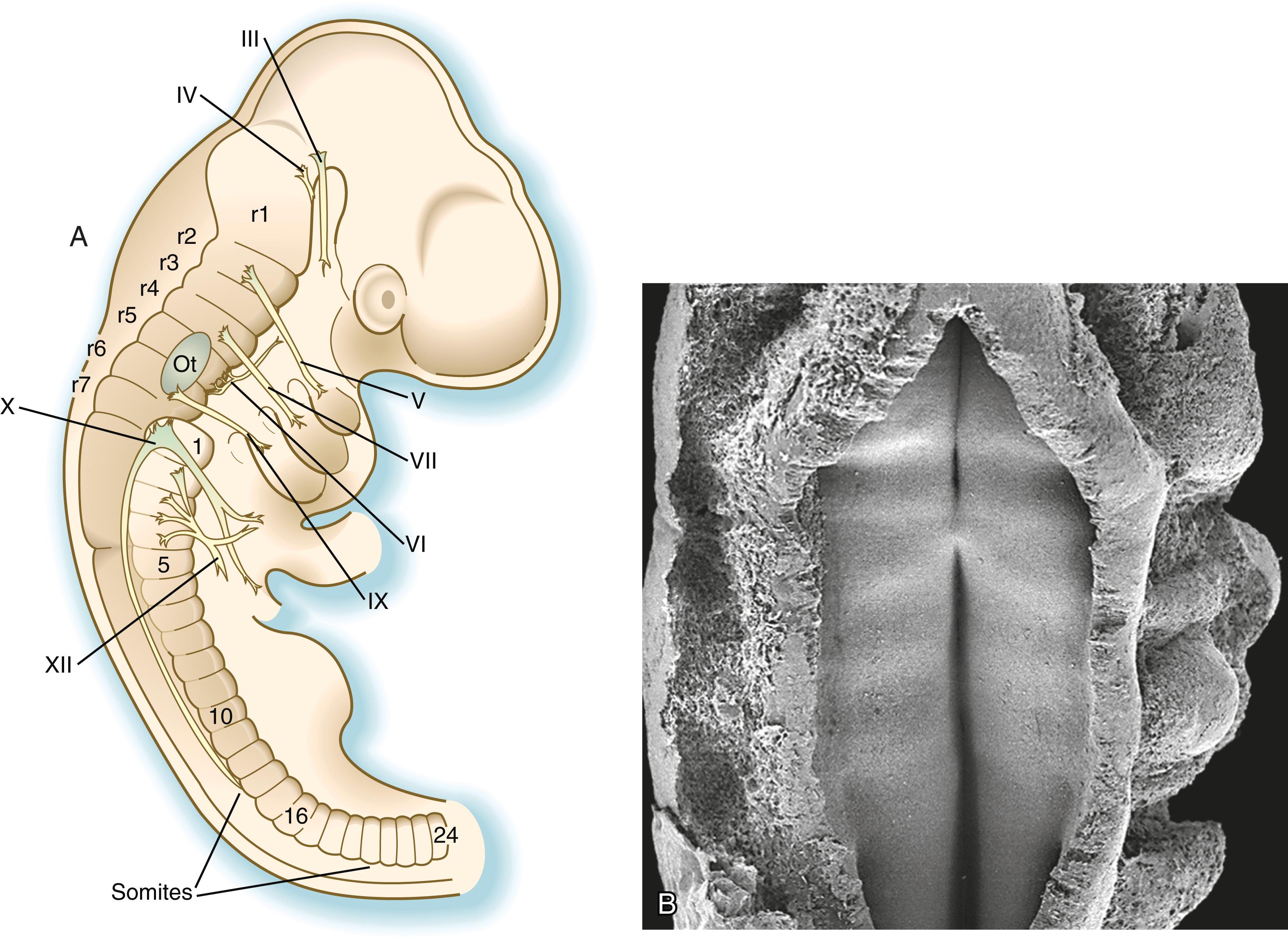
Rhombomeres are arranged as odd and even pairs, and when established, they act like isolated compartments in insect embryos. Because of specific surface properties involving Eph/ephrin signaling, cells from adjacent rhombomeres do not intermingle across boundaries between even and odd segments; however, marked cells from two even or two odd rhombomeres placed side by side do intermingle. During their brief existence, rhombomeres provide the basis for the fundamental organization of the hindbrain. In an adult, the segmental organization of the rhombomeres is manifest in the rhombomere-specific origin of many cranial nerves and parts of the reticular formation within the brainstem (see Figure 11.15 ).
While gastrulation is still taking place, the newly induced neural tube is subjected to vertical inductions from the notochord and head organizing regions (anterior visceral endoderm and prechordal plate), which are important in inducing the forebrain region. These inductions, together with a gradient of Wnt-8 (product of a gene homologous with Wingless , a segment polarity gene in Drosophila [see Figure 3.1 ]) signaling, effectively subdivide it into forebrain/midbrain and hindbrain/spinal cord segments. This subdivision is marked by the expression of two transcription factors, Otx-2 (orthodenticle homolog 2) in the forebrain/midbrain region and in the hindbrain, Gbx-2 (gastrulation brain homeobox 2), whose boundaries sharply define the midbrain–hindbrain border ( Figure 6.5A ). Fibroblast growth factors (FGFs), produced in the early primitive streak, are known to exert a posteriorizing effect on the newly forming neural plate.
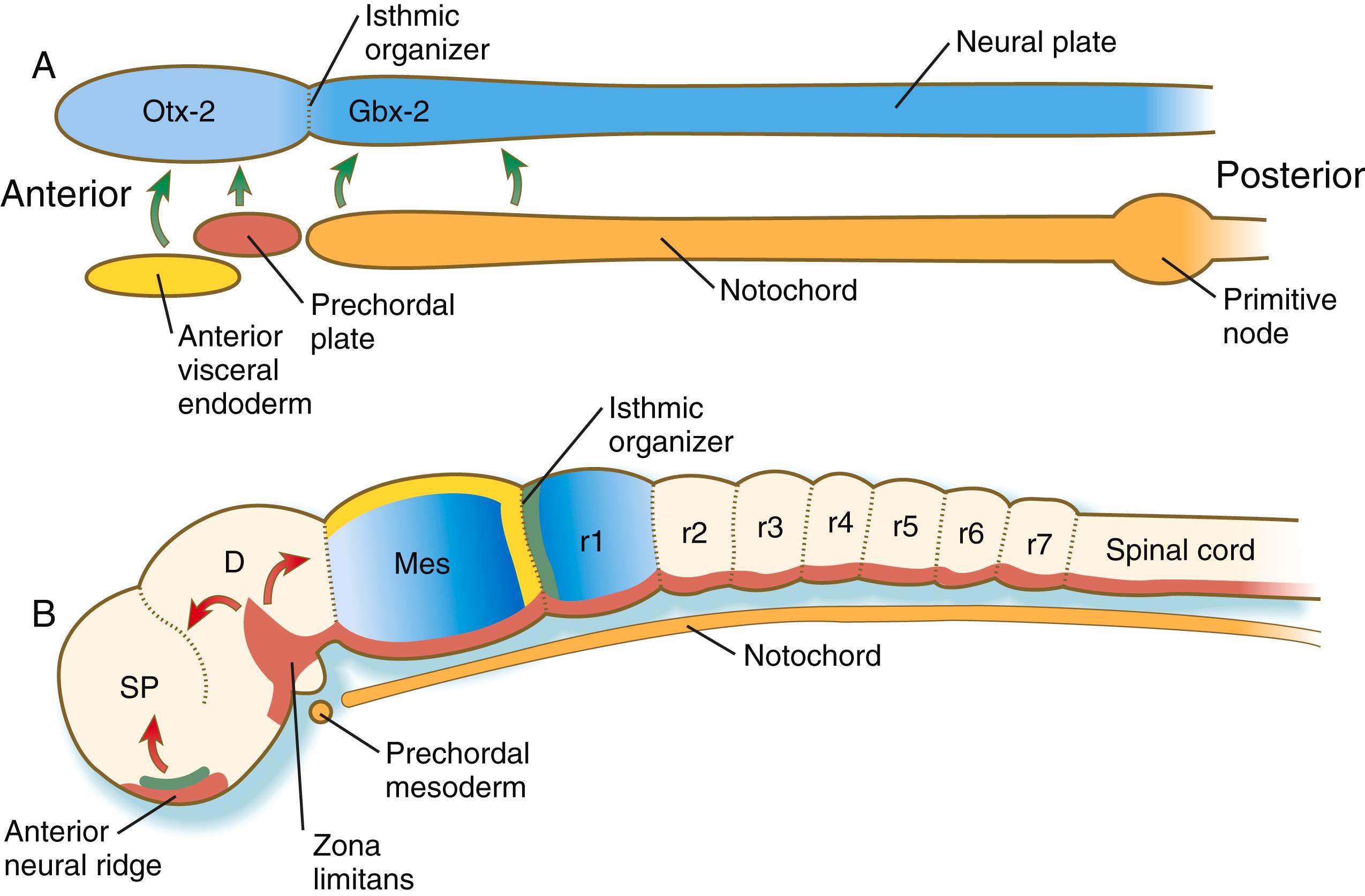
The midbrain–hindbrain border becomes a powerful local signaling center, called the isthmic organizer . Wnt-1 is synthesized in the neural ectoderm anterior, and FGF-8 is formed posterior to the isthmic organizer ( Figure 6.5B ). The transcription factors Pax-2 and Pax-5 and engrailed (En-1 and En-2 ) are expressed on both sides of the isthmic organizer as gradients that are crucial in organizing the development of the midbrain and the cerebellum, a hindbrain derivative.
Two additional organizing or signaling centers are established early in the formation of the forebrain region. One, the anterior neural rid ge, is located at the anterior pole of the brain (see Figure 6.5B ). The anterior neural ridge in mammals may represent what has been described in amphibian embryos as the e xtreme anterior domain , which is the organizing center for the lower face and the adenohypophysis. The anterior neural ridge is a site of sonic hedgehog and FGF-8 signaling activity and is important in organizing the formation of the secondary prosencephalon, parts of the diencephalon, the olfactory area, and the pituitary gland. A third signaling center, the zona limitans (see Figure 6.5B ), is a sonic hedgehog–secreting group of cells that organize the border between the future dorsal and ventral thalamus. Chapter 11 presents additional information on the organization and segmentation of the forebrain.
Segmentation of the hindbrain into seven rhombomeres in humans, and eight in some other animals, is the result of the expression of several categories of genes, which operate in a manner remarkably reminiscent of the way in which the early Drosophila embryo becomes subdivided into segments (see Figure 3.1 ). Individual rhombomeres are initially specified through the ordered expression of unique combinations of transcription factors; this patterning is then translated into cellular behavior by the patterned expression of cell surface molecules.
After the Gbx - 2–expressing area defines the rough limits of the hindbrain, several segmentation genes are involved in setting up the basic pattern of segmentation that leads to rhombomere formation. Krox 20 , a zinc finger transcription factor, is expressed in and guides the formation of rhombomeres 3 and 5 (r3 and r5) (see Figure 11.14 ), whereas kreisler , another transcription factor, and Hoxa-1 are also involved in the formation of r5. A decreasing posterior to anterior gradient of retinoic acid , produced by the anterior somites, plays an important role in the formation of the posterior rhombomeres (4r2 to r7) by activating arrays of Hox genes.
The Hox genes are principally involved in specifying segmental identity, but before any molecular marker of morphological segmentation exists, the previously mentioned gradient of retinoic acid stimulates the expression of Hoxa-1 and Hoxb-1 . The influence of these two Hox genes and of the segmentation genes, Krox 20 and kreisler , initiates the expression of the various Hox paralogs in a highly specific sequence along the hindbrain and spinal cord (see Figure 11.14 ). Krox 20 stimulates not only the expression of Hoxa-2 and Hoxb-2 , but it also directly stimulates the Eph/ephrin pathway (see below).
As seen in Chapter 11, Chapter 14 , the pattern of Hox gene expression determines the morphological identity of the cranial nerves and other pharyngeal arch derivatives that arise from specific rhombomeres. At successive times during the formation of the hindbrain, different regulatory networks controlling Hox gene expression come into play, but details of these networks are not presented in this text. The orderly expression of Hox gene paralogs extends anteriorly through r2. Hox proteins are not found in r1 largely because of the antagonistic action of FGF-8, which is produced in response to signals from the isthmic organizer at the anterior end of r1. In the absence of FGF-8, Hox proteins are expressed in r1. Another rhombencephalic protein, sprouty 2 , acts as an antagonist of FGF-8, and this protein, in addition to the presence of Hoxa-2 in r2, confines FGF-8 mostly to r1 and contains the primordium of the cerebellum to the anterior part of r1.
Another molecular family, the Eph/ephrins and their receptors, determines the behavioral properties of the cells in the rhombomeres. The action of ephrins, which are expressed in even-numbered rhombomeres (2, 4, and 6), and of ephrin receptors, which are expressed in odd-numbered rhombomeres (3 and 5), accounts for the lack of mixing behavior of cells from adjacent rhombomeres and maintains the separation of the various streams of neural crest cells that emigrate from the rhombomeres (see Figure 12.9 ). As an example of the complexity of the molecular interactions involved in formation of the rhombomeres, Krox 20 directly regulates not only Hox gene expression, which confers identity to r3 and r5, but also the expression of EphA , which determines cellular behavior at the rhombomere boundaries.
Although neuromeres are not seen in the region of the neural tube that gives rise to the spinal cord, the regular arrangement of the exiting motor and sensory nerve roots is evidence of a fundamental segmental organization in this region of the body as well. Segmentation of the spinal cord is to a great extent imposed by signals emanating from the paraxial mesoderm, specifically, the somites.
While the body axis is elongating and somites are forming, the caudalmost part, called the caudal lateral epiblast , possesses the properties of a stem cell zone ( Figure 6.6 ). Under the influence of FGF-8, secreted by the adjacent presomitic paraxial mesoderm, the neuromesodermal progenitor cells within the stem cell zone, which are characterized by expressing the transcription factors T/Bra and Sox 2 , proliferate without undergoing differentiation. Some of the daughter cells left behind by the posteriorly advancing stem cell zone fall under the influence of retinoic acid, which stimulates Sox 2 expression and inhibits the expression of T/Bra . These cells will differentiate into neural tissue ( Figure 6.7 ). In other cells, Sox 2 expression is inhibited by Tbx 6 . These cells become committed to the mesodermal lineage.
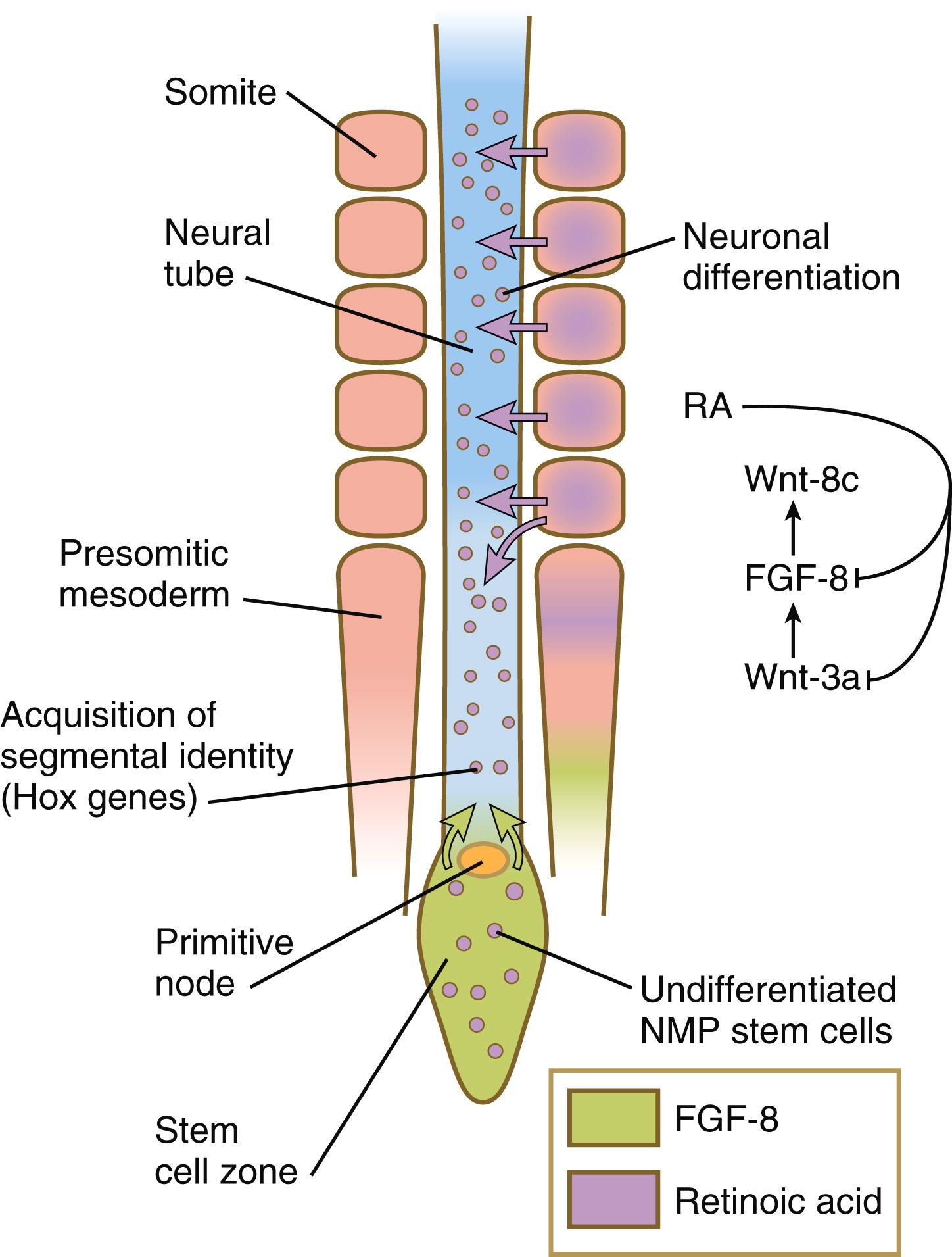
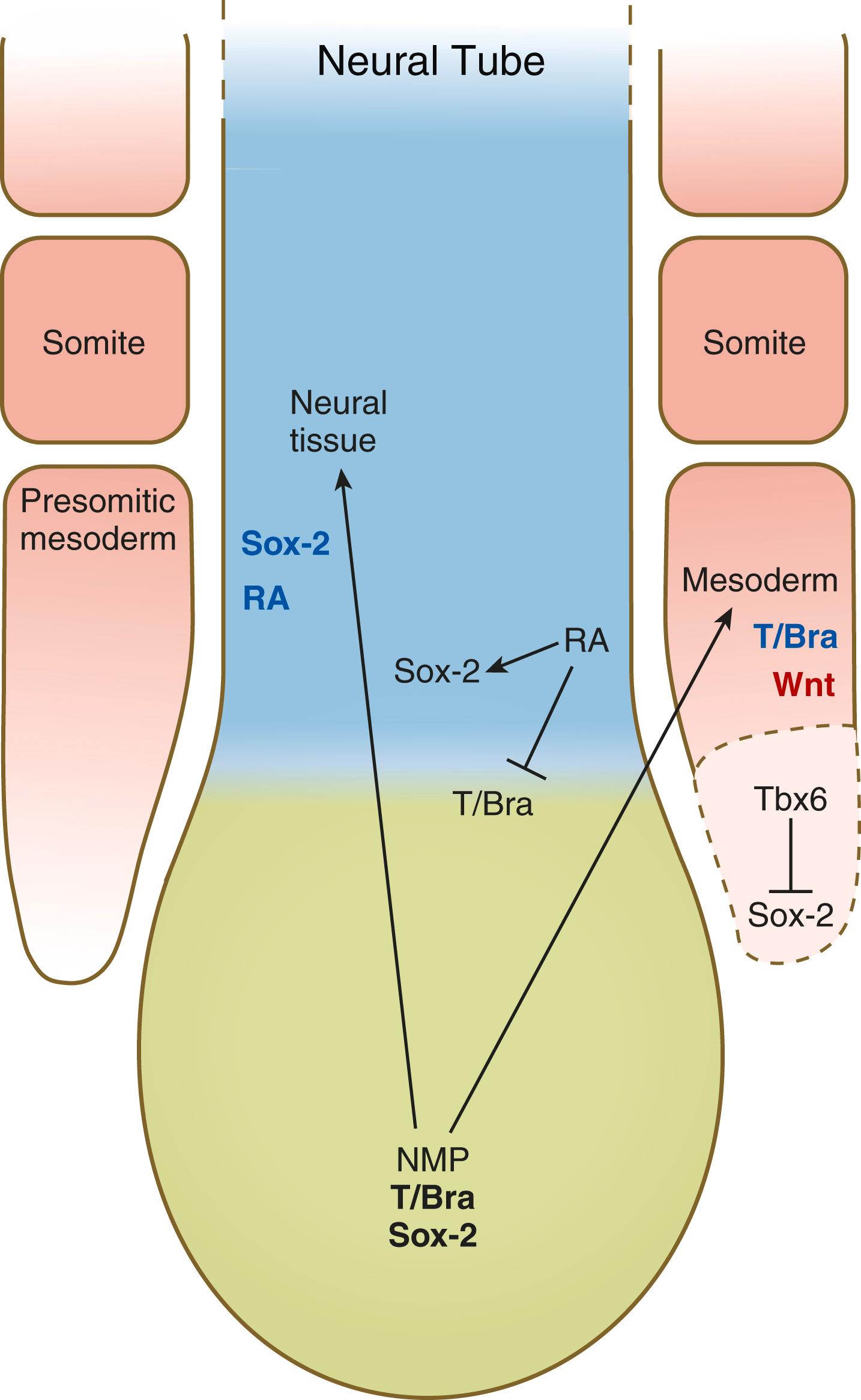
Elongation of the tail bud region closes when the caudal extent of presomitic mesoderm is reduced, thus allowing the retinoic acid produced in the area to diffuse farther posteriorly and inhibit the action of FGF-8. As a result, proliferation of tail bud mesenchyme is greatly reduced, causing growth to cease.
The opposing actions of retinoic acid, which promotes differentiation, and FGF, which fosters proliferation at the expense of differentiation, represent a recurring theme in the development of other structures. For example, the spread of FGF-8 from the isthmic organizer (see Figure 6.5B ) antagonizes the influence of retinoic acid in r1. This permits the exuberant proliferation of the cells in this rhombomere, which is necessary for the formation of the large cerebellum from this structure. Interactions between FGF-8 and retinoic acid in the forming spinal cord and paraxial mesoderm help set the Hox code that confers anteroposterior identity to regions of the spinal cord and the adjacent somites. Major steps involved in formation of the entire anteroposterior axis of the body are summarized in Box 6.1 .
Neural induction (see p. 83) results in the subdivision of the embryonic ectoderm into the neural plate and generic ectoderm. The molecular basis underlying this subdivision is the local inhibition of bone morphogenetic protein (BMP) activity, specifying midline ectodermal cells to become future neural tissue through a default mechanism. The midline inhibition of BMP results in a gradient of BMP activity, from high laterally to low in the midline. Ectodermal cells at the border between neural plate and surface ectoderm are exposed to intermediate levels of BMP and develop molecular characteristics that fit neither those of the neural plate or the surface ectoderm. These cells constitute the neural border ( Figure 6.9 ), which gives rise to two important embryonic precursor tissues—the neural crest and the preplacodal region . Cells from both the neural crest and the preplacodal region differentiate into numerous derivatives. Each decision point is governed by unique molecular combinations, which at times use the same molecules in ways that may be as different as stimulatory at one point and inhibitory at another.
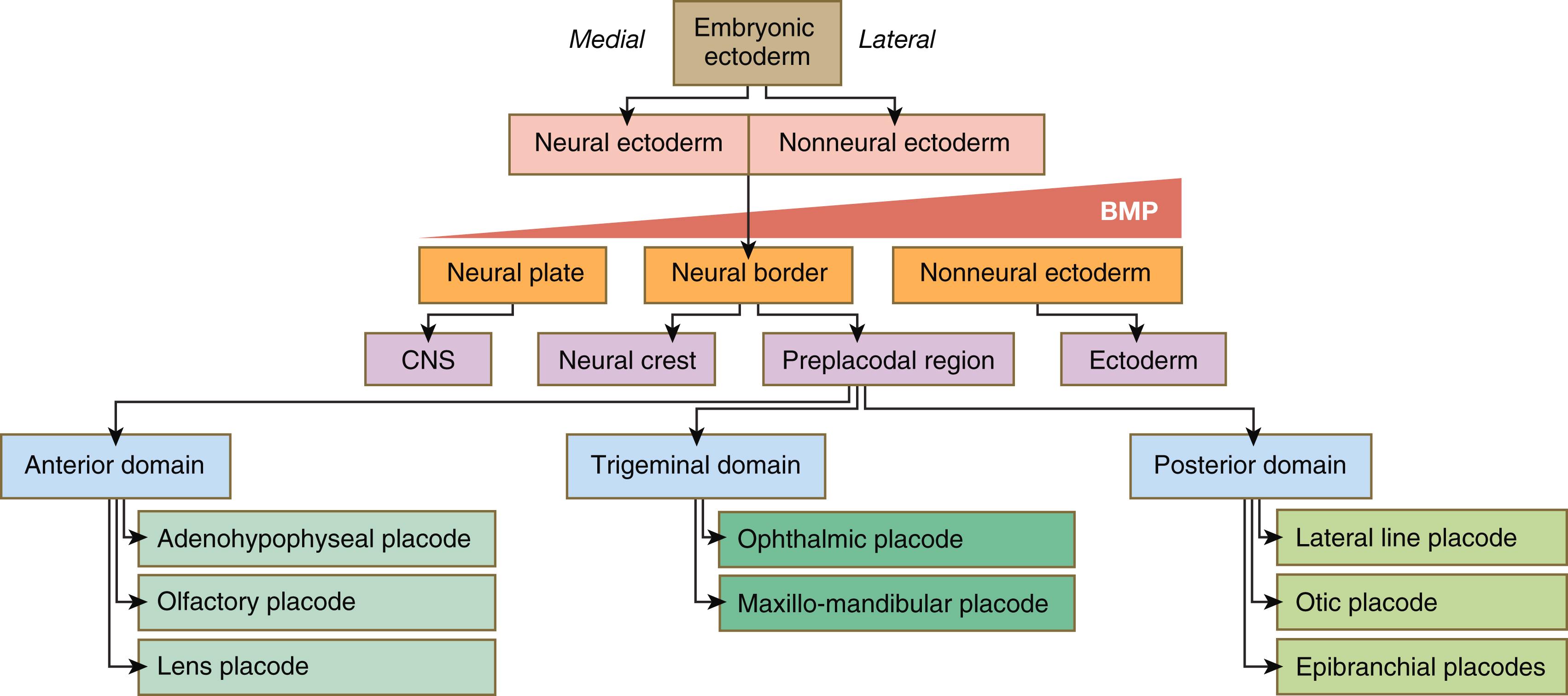
Subdivision of the neural border into neural crest and preplacodal domains occurs during gastrulation ( Figure 6.10 ). The early preplacodal region is rostral to the neural crest, and their relative locations reflect the molecular signaling environments in which their precursor cells were exposed. The anterior preplacodal region arises as a result of its precursor cells being exposed to a burst of cranial FGF activity, whereas exposure of more posterior precursor cells to BMP and Wnt stimulates their entering the neural crest pathway. The high Wnt environment in the posterior part of the embryo confines the preplacodal region to the cranial area, whereas the molecular environment surrounding the most anterior part of the neural plate does not permit the formation of neural crest in that area. In response to these various signals, the neural crest and preplacodal domains and their successor structures express unique sets of transcription factors that determine their specific identity.
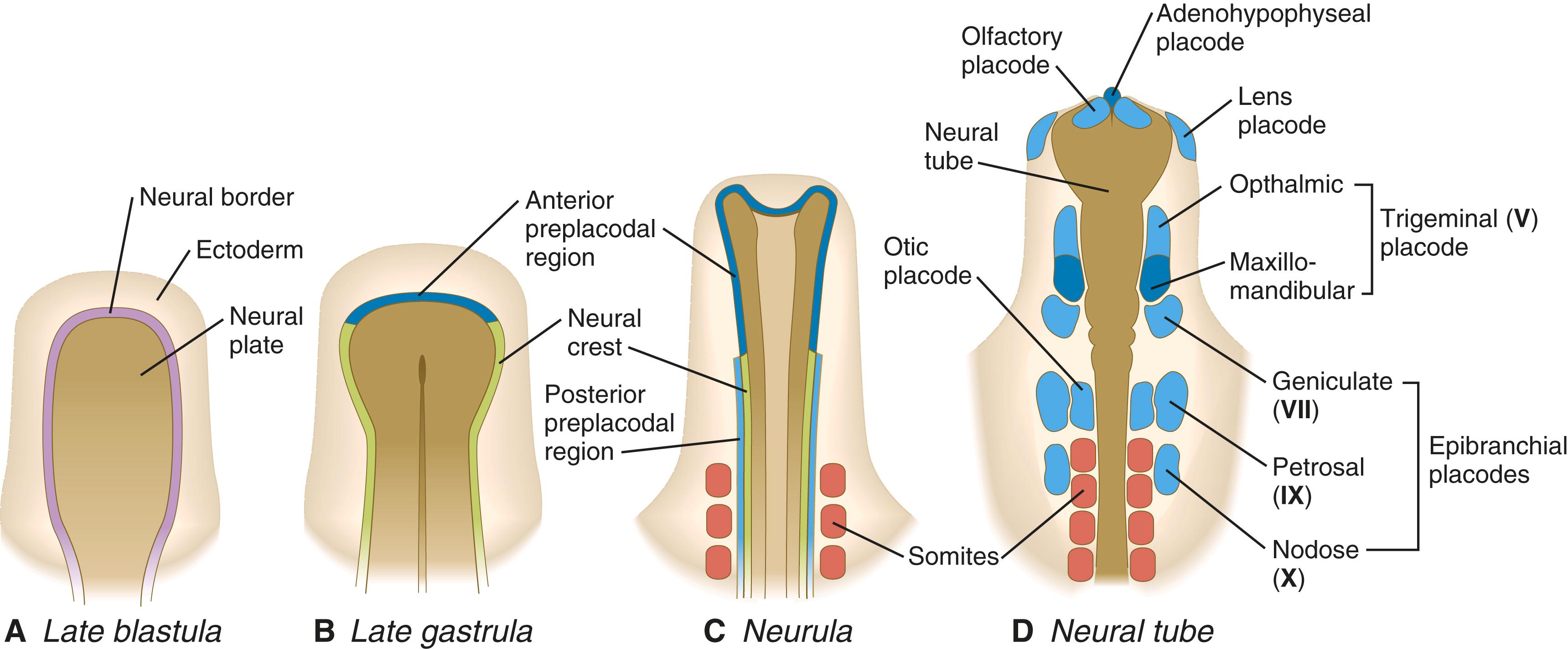
While the neural tube is closing and separating from the general cutaneous ectoderm, cells from the newly induced neural crest leave the dorsal part of the neural tube (the former neural border region) and begin to spread throughout the body of the embryo (see Figure 6.2 ). The neural crest produces an astonishing array of structures in the embryo (see Table 12.1 ), and its importance is such that the neural crest is sometimes called the fourth germ layer of the body. (The neural crest is discussed at length in Chapter 12 .)
During neurulation, three preplacodal domains are established. Each will produce precursors of distinct adult structures. The anterior domain produces a midline adenohypophyseal placode , a pair of olfactory placodes, and a pair of lens placodes . The posterior domain gives rise to the paired otic placodes and three pairs of epibranchial placodes . Between these two domains is a separate two-part trigeminal placode . The epibranchial placodes are so-named because phylogenetically they are associated with placodes located above the gill arches of aquatic vertebrates. Each of these divisions and the subsequent subdivisions is the product of the actions of different sets of signaling molecules.
With just a few exceptions, the placodes give rise to sensory neurons (see Chapter 13 ), often in conjunction with sensory neurons derived from the neural crest. Specifically, cells from the placodes and neural crest interact closely to form the sensory ganglia of cranial nerves V, VII, IX, and X. Deficiencies of one of these two components can often be replaced by an increased contribution from the other component. The midline adenohypophyseal placode and the paired lens placodes do not produce neurons. Instead, cells of the former placode generate the lines of hormone-producing cells found in the adenohypophysis, and those of the lens placode produce the specialized lens fibers seen in the lens (see p. 278). Further details of placodes and their developmental fate are given in Chapter 13 .
During gastrulation, mesendodermal cells are specified by nodal . Cells exposed to high levels of nodal signaling become specified to form endoderm, whereas those exposed to lower levels become mesoderm. After passing through the primitive streak, the mesodermal cells spread laterally between the ectoderm and endoderm as a continuous layer of mesenchymal cells (see Figure 5.7 ). Subsequently, three regions can be recognized in the mesoderm of cross-sectioned embryos ( Figure 6.11B ). Nearest the neural tube is a thickened column of mesenchymal cells known as the paraxial mesoderm, or segmental plate . This tissue soon becomes organized into somites. Lateral to the paraxial mesoderm is a compact region of intermediate mesoderm, which ultimately gives rise to the urogenital system. Beyond that, the lateral plate mesoderm ultimately splits into two layers and forms the bulk of the tissues of the body wall, the wall of the digestive tract, and the limbs (see Figure 6.32 ).
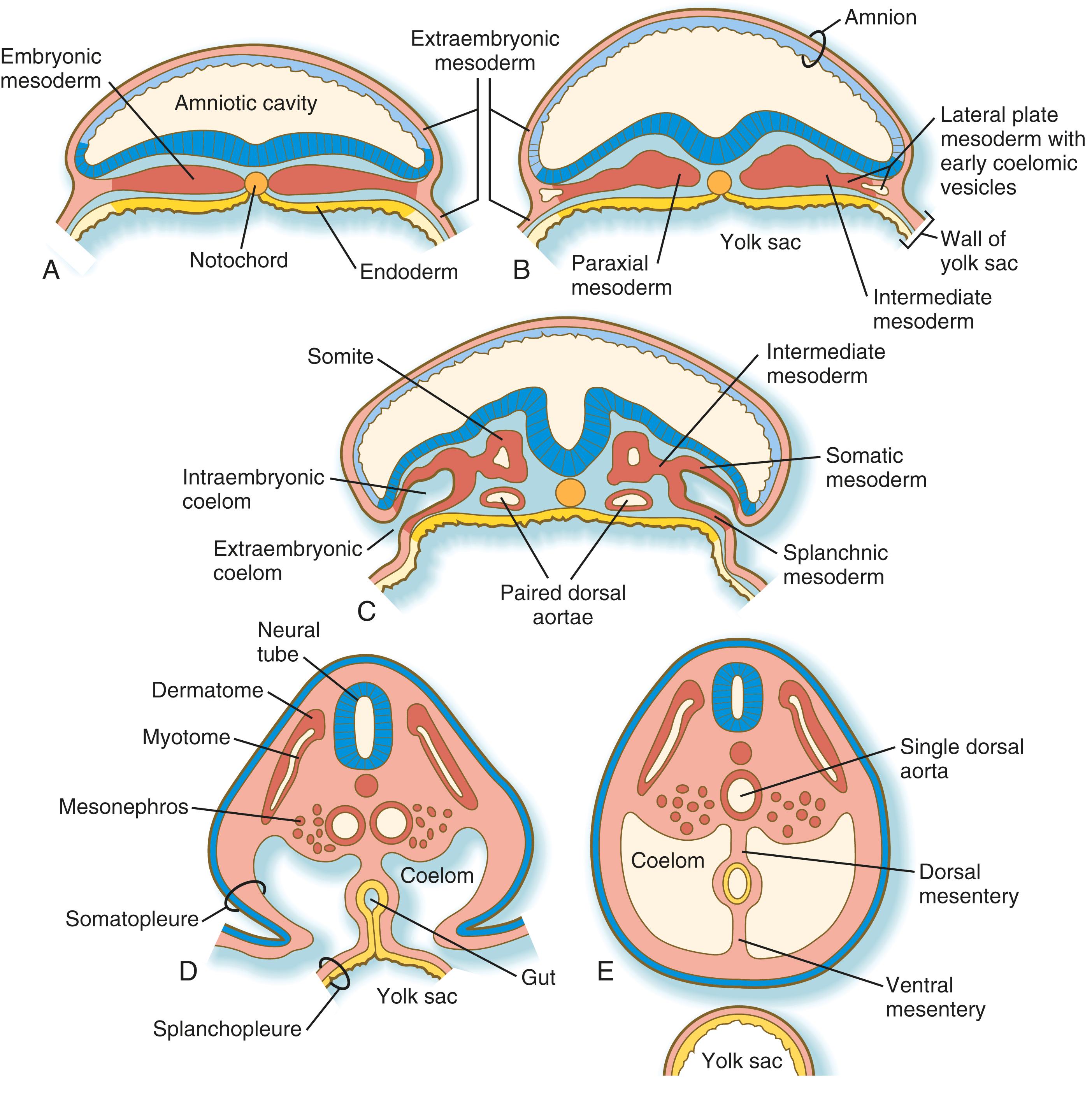
Like the ectoderm (p. 97), mesodermal cells respond to the mediolateral gradient of BMP activity. Laterally, BMP activity is high, but BMP inhibitors such as noggin, produced in the midline, antagonize the effect of BMP. Responding to this gradient, cells exposed to low concentrations of BMP near the midline develop into paraxial mesoderm. Those exposed to intermediate levels become intermediate mesoderm, and those exposed to the highest levels become lateral mesoderm and, finally, extraembryonic mesoderm.
Become a Clinical Tree membership for Full access and enjoy Unlimited articles
If you are a member. Log in here